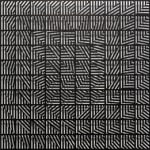Mehdi Moutashar French-Iraqi, b. 1943
Mouvement 9.2 (Movement 9.2), 2016
Painted steel (laser cut)
122 x 122 x 4 cm
48 3/100 x 48 3/100 x 1 28/50 inches
48 3/100 x 48 3/100 x 1 28/50 inches
Further images
In his Mouvement series, Mehdi Moutashar revisits and reinterprets his lost geometric paintings from the late 1960s, transforming them into a new medium that reflects both his artistic evolution and...
In his Mouvement series, Mehdi Moutashar revisits and reinterprets his lost geometric paintings from the late 1960s, transforming them into a new medium that reflects both his artistic evolution and the changing technological landscape. The original works, which were created on paper and canvas, explored the possibilities of geometric abstraction, utilizing clean lines, balanced compositions, and a strong sense of rhythm. With the Mouvement series, Moutashar seeks to rebuild the energy and essence of these works, while introducing a contemporary, more dynamic approach.
Instead of adhering to the traditional mediums of paper or canvas, Moutashar has opted for laser-cut steel, painted either in bold blue or deep black. This choice of material introduces a significant shift in the way the works are perceived. The steel’s industrial quality contrasts sharply with the softness of paper or fabric, giving the geometric forms a sense of permanence and solidity. The laser-cut process itself brings precision and sharpness to the forms, allowing for intricate details that are impossible to achieve through traditional painting techniques. The result is a piece that is at once meticulously crafted and bold in its expression.
The use of steel also opens up new possibilities for optical effects. The works are not static; they shift and transform depending on the viewer’s position and the surrounding light, creating shadows on the wall behind the work itself. This dynamic quality encourages interaction with the work, inviting the viewer to experience the changing perspectives and visual depth that Moutashar’s original 1960s paintings may have only hinted at. The interplay between the static forms and their ever-changing presentation adds a new layer of complexity to the original geometric exploration, making each viewing experience unique.
Instead of adhering to the traditional mediums of paper or canvas, Moutashar has opted for laser-cut steel, painted either in bold blue or deep black. This choice of material introduces a significant shift in the way the works are perceived. The steel’s industrial quality contrasts sharply with the softness of paper or fabric, giving the geometric forms a sense of permanence and solidity. The laser-cut process itself brings precision and sharpness to the forms, allowing for intricate details that are impossible to achieve through traditional painting techniques. The result is a piece that is at once meticulously crafted and bold in its expression.
The use of steel also opens up new possibilities for optical effects. The works are not static; they shift and transform depending on the viewer’s position and the surrounding light, creating shadows on the wall behind the work itself. This dynamic quality encourages interaction with the work, inviting the viewer to experience the changing perspectives and visual depth that Moutashar’s original 1960s paintings may have only hinted at. The interplay between the static forms and their ever-changing presentation adds a new layer of complexity to the original geometric exploration, making each viewing experience unique.








